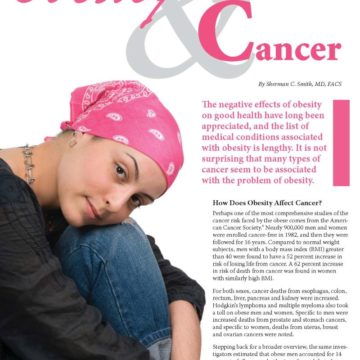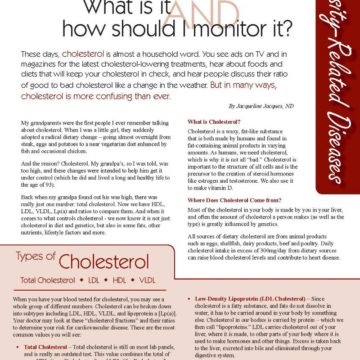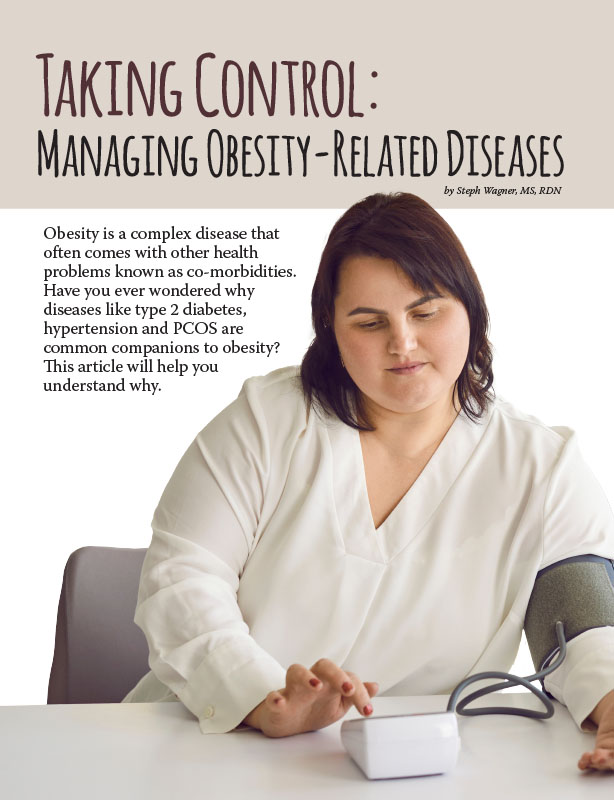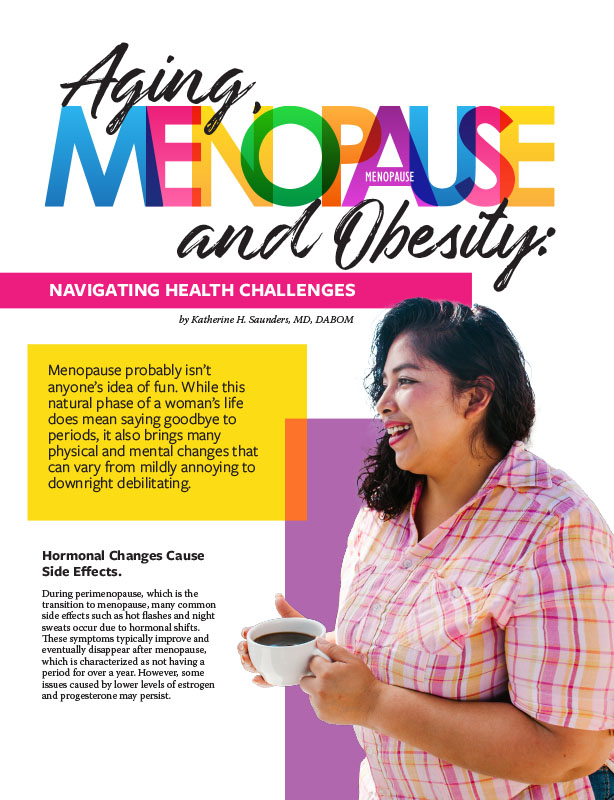Hypertension and Obesity: How Weight-loss Affects Hypertension

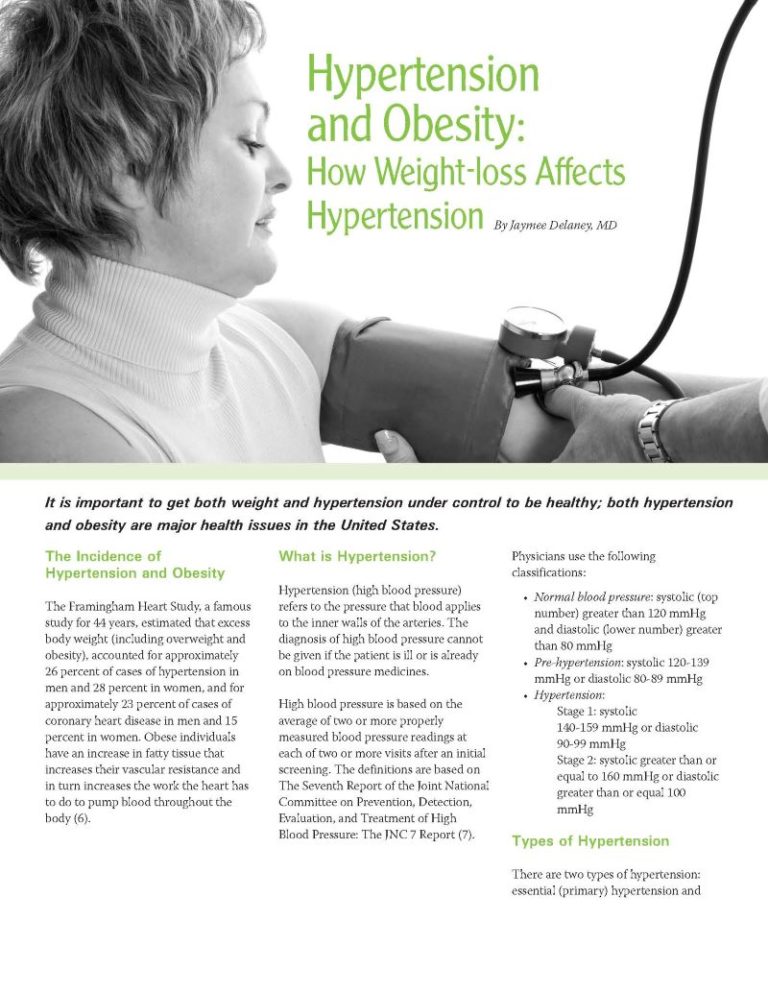
by Jaymee Delaney, MD
Winter 2009
It is important to get both weight and hypertension under control to be healthy; both hypertension and obesity are major health issues in the United States.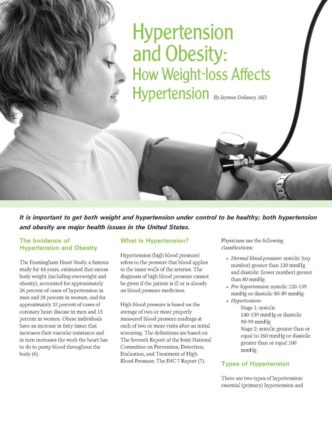
The Incidence of Hypertension and Obesity
The Framingham Heart Study, a famous study for 44 years, estimated that excess body weight (including overweight and obesity), accounted for approximately 26 percent of cases of hypertension in men and 28 percent in women, and for approximately 23 percent of cases of coronary heart disease in men and 15 percent in women. Individuals with obesity have an increase in fatty tissue that increases their vascular resistance and in turn increases the work the heart has to do to pump blood throughout the body (6).
What is Hypertension?
Hypertension (high blood pressure) refers to the pressure that blood applies to the inner walls of the arteries. The diagnosis of high blood pressure cannot be given if the patient is ill or is already on blood pressure medicines.
High blood pressure is based on the average of two or more properly measured blood pressure readings at each of two or more visits after an initial screening. The definitions are based on The Seventh Report of the Joint National Committee on Prevention, Detection, Evaluation, and Treatment of High Blood Pressure: The JNC 7 Report (7).
Physicians use the following classifications:
- Normal blood pressure: systolic (top number) equal to or less than 120 mmHg and diastolic (lower number) equal to or less than 80 mmHg
- Pre-hypertension: systolic 120-139 mmHg or diastolic 80-89 mmHg
- Hypertension:
Stage 1: systolic 140-159 mmHg or diastolic 90-99 mmHg
Stage 2: systolic greater than or equal to 160 mmHg or diastolic greater than or equal 100 mmHg
Types of Hypertension
There are two types of hypertension: essential (primary) hypertension and secondary hypertension. Most people with hypertension have essential hypertension.
Essential hypertension is poorly understood and may be due to a number causes including inheritance, kidney problems (from hypoxia, drugs, nutritional deficiency, malnutrition, infection, genetic factors) and neural activity.
Secondary hypertension is less common and is the result of a different underlying medical issue, such as kidney disease, oral contraceptives, pheochromocytoma, primary hyperaldosteronism, Cushing’s syndrome, sleep apnea syndrome and coarctation of the aorta.
Treating Hypertension
People with hypertension should be on blood pressure medications (antihypertensives). Those who are placed on medication for high blood pressure need to realize that everyone responds differently to these medications and two to three drugs may be required to achieve a normal blood pressure.
If weight-loss occurs and a normal blood pressure is achieved, then blood pressure medications may be tapered or stopped. No medical studies have found whether certain blood pressure medicines work better or are safer in patients with obesity. There are many types of medicines that can be used and physicians should discuss the risks and benefits of the choices that are available.
Possible choices are:
- ACE inhibitors
- Low dose diuretic (12.5 to 25 mg of hydrochlorothiazide per day)
- Calcium channel blocker
Low-dose thiazide therapy is less expensive and should have little or no effect on glucose or lipid metabolism, which may be an issue with other antihypertensive drugs.
Knowing Your Risk for Hypertension
Indicators for risk of hypertension include obesity, abdominal obesity and weight gain. Obesity is measured by body mass index (BMI), which is determined by weight and height. BMI is highly correlated with direct measures of body fat in most populations. Normal BMI is 20-25, overweight is 25-29.9 and obesity is greater than 30 (5). Not only is BMI important for determining hypertension risk, but fat distribution is as well.
Fat distribution in the abdominal trunk is called abdominal obesity. Abdominal obesity is defined by a waist circumference greater than 102 cm (40in) for men and 88 cm (35 in) for women (9,10). Abdominal obesity has the greatest influence on whether someone will develop hypertension.
Weight gain was associated with an increased risk of developing hypertension. The relative risks of hypertension in women who gained 10-22 pounds and those that gained over 55 pounds were 1.7 and 5.2, respectively. In other words, women that gained more than 55 pounds were three times as likely to become hypertensive as women who had gained less weight.
On the other hand, weight-loss can lead to a significant drop in blood pressure. One study showed that in a four year follow-up of 181 overweight hypertensive patients, a 10 percent weight-loss produced an average of a 4.3/3.8 mmHg fall in blood pressure.
Patients with obesity have other significant health risks, and patients with abdominal (central or upper body) obesity are at the greatest risk. Heart disease risk increases if a person has excess abdominal fat, high blood pressure, high levels of cholesterol in the blood, heart disease, a strong family history of diabetes, is a male or was affected by obesity before age 40.
The abnormalities in lipid and glucose metabolism appear to be related to fat distribution and to total body weight, and this is why patients with obesity have a higher rate of diabetes mellitus.
Obesity increases heart disease risk by increasing LDL-cholesterol levels (bad cholesterol) and reducing HDL-cholesterol levels (good cholesterol). This produces atherosclerosis (hardening of the heart arteries), which can cause myocardial infarction (heart attacks).
Obesity also increases the risk of diabetes by diminishing glucose tolerance and predisposing to the development of left ventricular hypertrophy (enlargement of the heart) (11,12). Left ventricular hypertrophy can be produced in patients with obesity because the heart is required to work harder to pump blood throughout the body. By some estimates, each pound of fat requires approximately a mile of extra blood vessels to supply nutrients and oxygen (13).
Did You Know?
Obesity and hypertension (high blood pressure) are intimately connected. There are 58 to 65 million adults who have hypertension in the United States (1,2). Hypertension is the most common reason for office visits of non-pregnant adults to their physicians and for the use of prescription drugs (3), and people with obesity are more likely to have hypertension (5).
The percentage of people with obesity in the United States is increasing and in a survey from 1999 to 2000, the percentage of people with obesity in the United States was 33.5 percent (4). Other medical issues that are associated with obesity include reduced life expectancy, coronary heart disease, diabetes mellitus, gallstones, osteoarthritis, abnormal cholesterol (blood lipids), stroke, sleep apnea, cancer (colon and prostate in men; uterine and gallbladder cancer in women).
What to Remember with Hypertension and Obesity
The most important issue to remember is that obesity is associated with hypertension, and hypertension is associated with numerous other diseases that can affect overall health and life expectancy. Anti-hypertension medications should be started if hypertension is diagnosed. But, with weight-loss, a significant fall in blood pressure may permit a decrease in the number of medications taken or decrease the amount of medication taken. Prevention would be better than any drug.
Use lifestyle changes with weight reduction (maintaining BMI 18.5 to 24.9 kg/m2), DASH diet (eating fruits, vegetables, and low-fat dairy products with reduced content of saturated and total fat), a decrease in dietary sodium (2.4 g sodium or 6 g sodium chloride), an increase in physical activity (for 30 minutes per day) and moderate consumption of alcohol. Weight-loss is the most important step in reducing hypertension and improving quality of life.
About the Author:
Jaymee Delaney, MD, is an Internal Medicine Physician in Tualatin, Oregon. She received her medical degree from Oregon Health Sciences University and did her residency at Legacy Hospital Program. She is a member of the Oregon Medical Association, which advocates and supports legislation on obesity issues. She is also an Advisory Board and Chairman’s Council member of the OAC. Her personal and professional interest lies with both adult and childhood obesity. Dr. Delaney has successfully influenced numerous patients on changing their lifestyles and to pursue healthier habits.
References:
1. Fields, LE, Burt, VL, Cutler, JA, et al. The burden of adult hypertension in the United States 1999 to 2000: a rising tide. Hypertension 2004; 44:398.
2. Burt, VL, Whelton, P, Roccella, EJ, et al. Prevalence of hypertension in the US adult population. Results from the Third National Health and Nutrition Examination Survey, 1988-1991. Hypertension 1995; 25:305.
3. Cherry, DK, Burt, CW, Woodwell, DA. Advance data from vital and health statistics. No 337. Hyattsville, MD. National Center for Health Statistics, 2003.
4. Ogden, CL, Carroll, MD, Curtin, LR, et al. Prevalence of overweight and obesity in the United States, 1999-2004. JAMA 2006; 295:1540.
5. Poirier, P, Giles, T, Bray, G, et al. Obesity and Cardiovascular Disease: Pathophysiology, Evaluation, and Effect of Weight-loss. Circulation 2006; 113:898.
6. Schmieder, RE, Messerli, FH. Does obesity influence early target organ damage in hypertensive patients? Circulation 1993; 87:1482.
7. Chobanian, AV, Bakris, GL, Black, HR, et al. The Seventh Report of the Joint National Committee on Prevention, Detection, Evaluation, and Treatment of High Blood Pressure: The JNC 7 Report. JAMA 2003; 289:2560.
8. Sharma, AM, Pischon, T, Engeli, S, Scholze, J. Choice of drug treatment for Obesity-related hypertension: where is the evidence?. J Hypertens 2001; 19:667.
9. Unger, RH. Reinventing type 2 diabetes: pathogenesis, treatment, and prevention. JAMA 2008; 299:1185.
10. Nyamdorj, R, Qiao, Q, Soderberg, S, et al. Comparison of body mass index with waist circumference, waist-to-hip ratio, and waist-to-stature ratio as a predictor of hypertension incidence in Mauritius. J Hypertens 2008; 26:866.
11. Ostlund, RE Jr, Staten, M, Kohrt, WM, et al. The ratio of waist-to-hip circumference, plasma insulin level, and glucose intolerance as independent predictors of the HDL2 cholesterol level in older adults. N Engl J Med 1990; 322:229.
12. Lauer, MS, Anderson, KM, Kannel, WB, Levy, D. The impact of obesity on left ventricular mass and geometry. The Framingham Heart Study. JAMA 1991; 266:231.
13. Folkman, Judah. Harvard Professor. From his early work on angiogenesis (one pound of fat).
by Steph Wagner, MS, RDN Spring 2024 Obesity is a complex disease that often comes with other…
Read Articleby Katherine H. Saunders, MD, DABOM Spring 2024 Menopause probably isn’t anyone’s idea of fun. While this…
Read Articleby Sarah Ro, MD; and Young Whang, MD, PhD Fall 2023 Mary, a postmenopausal woman with a…
Read Article




